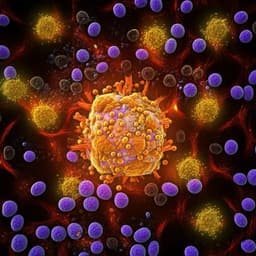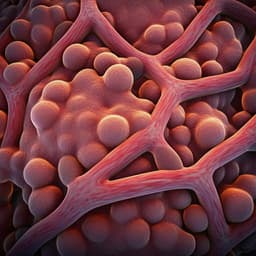
Engineering and Technology
Design principles for efficient photoelectrodes in solar rechargeable redox flow cell applications
D. Bae, G. Kanellos, et al.
Discover innovative design principles for photoelectrodes in solar rechargeable redox flow cells researched by Dowon Bae, Gerasimos Kanellos, Gerrit M. Faasse, Emil Dražević, Anirudh Venugopal, and Wilson A. Smith. Their groundbreaking work achieves over 9.4% solar-to-chemical conversion efficiency, addressing redox kinetics limitations. Join the push for better energy conversion!
~3 min • Beginner • English
Introduction
The study addresses the challenge of efficiently integrating solar energy conversion and storage using photoelectrochemical redox flow cells (solar redox flow batteries, SRFBs). While SRFBs offer flexible redox potentials, safer operation, and decoupled energy and power, their implementation is hindered by sluggish redox kinetics at the photoelectrode/liquid interface, leading to large overpotentials and limited photo-charging performance. Prior work showed promising efficiencies using small band-gap semiconductors and tandem devices, but single-junction devices often suffer from poor interfacial charge transfer. The authors hypothesize that careful band alignment and surface coverage of conducting layers on photoelectrodes can reduce charge extraction barriers and enable efficient carrier pathways for both n- and p-type silicon photoelectrodes, thereby enhancing solar-to-chemical (STC) efficiency. The purpose is to reveal interfacial design principles, quantify their impact, and demonstrate high-efficiency single-photon photo-charging in SRFBs.
Literature Review
The paper reviews early and recent demonstrations of solar redox storage cells since Hodes et al. (1976), including systems using c-Si and WSe2 with meaningful efficiencies and later tandem a-Si and III–V devices yielding double-digit STC (12.3–14.1%). SRFBs differ from PEC water splitting by allowing flexibility in redox potentials (wider choice of bandgaps) and generally faster RFB electrode kinetics. However, contrary to conventional RFBs, many SRFB photoelectrodes show slow interfacial kinetics for ferri/ferrocyanide reactions, with high overpotentials (~300–400 mV at 10 mA cm−2) reported for Si-based devices. High-voltage multijunctions can compensate but face techno-economic barriers. The authors highlight a gap: interfacial band alignment and coverage effects widely studied in PEC water splitting have been underexplored in SRFBs, especially regarding how conducting layer material and coverage influence redox kinetics at photoelectrode interfaces.
Methodology
- Materials and device structures: Crystalline Si photoelectrodes with buried pn junctions enabling back-side illumination were prepared on p- and n-type Cz c-Si wafers (350 μm, 1–20 Ω cm). Configurations included Pt/Ti/np+-Si/Au (photocathode), C/Ti/np+-Si/Au (photocathode), Pt/pn+-Si/Au (photoanode), and Pt nanoparticle (NP)/np+-Si/Au (photoanode).
- Conducting/protection layers: Thin Pt films (5–7 nm) and carbon films were deposited by sputtering under varied working pressures and deposition times to control thickness and coverage. TiO2 protection layers were sputtered with a Ti interlayer to prevent Si oxidation during high-temperature deposition. Pt nanoparticles were deposited with a loading of 200 ng cm−2.
- Electrochemical characterization: Linear sweep voltammetry (LSV) in the dark assessed ferricyanide reduction on highly doped n+-Si with different surfaces: bare Si, Pt, carbon, TiO2, Pt/TiO2, and C/TiO2. LSVs were measured in 0.4 M Fe(CN)6^{3−} with 1 M NH4Cl (pH 7). Mott-Schottky analysis was used where applicable (semiconductor/liquid junctions) to estimate flatband potentials and depletion widths (e.g., TiO2).
- Photoelectrochemistry: Three-electrode LSVs under AM1.5G illumination (100 mW cm−2) evaluated half-cell behavior versus carbon felt counter and Hg/HgSO4 reference. Two-electrode photo-charging experiments used Nafion-separated cells with redox couples: Fe(CN)6^{4−}/TEMPO-sulfate, Fe(CN)6^{4−}/Br2/Br−, and Cu^{2+}/Fe(CN)6^{4−}. Electrolytes: 0.4 M ferri/ferrocyanide and TEMPO in 1 M NH4Cl (pH 7); NH4Br anolyte; CuSO4 in H2SO4 (pH 2). Electrolytes were N2-purged and circulated at 70 mL min−1.
- Surface/coverage analysis: Quartz crystal microbalance (QCM) monitored deposition rate; AFM (PeakForce tapping) and profilometry quantified carbon island distribution, height, and film thickness vs deposition time and pressure. SEM verified Pt film morphology.
- Band alignment and transport modeling: Energy band diagrams at the electrolyte interface were constructed to infer tunneling/Schottky barriers for different stacks (bare Si, TiO2, Pt, Pt/TiO2; and by analogy, C). Tunneling and pinch-off effects were analyzed using depletion width estimates and the WKB approximation.
- Efficiency modeling: Theoretical STC limits were computed using a detailed-balance-inspired model (Shockley–Queisser framework) combined with Butler–Volmer kinetics for single-electron transfer, incorporating photovoltage (Voc), series resistance (Rs), kinetic overpotential (η), and SOC-dependent cell voltage. Experimental STC values at given SOCs were compared to model predictions.
Key Findings
- Material and interlayer effects on dark kinetics: Pt and carbon films on n+-Si exhibit high onset potentials for Fe(CN)6^{3−} reduction (~0.5 V_NHE at 10 mA cm−2), while bare Si is poor due to surface oxidation/silanol formation. TiO2 alone shows poor activity (Schottky barrier with E_FB ≈ 0.32 V; depletion width ~4.2 nm). Pt/TiO2 remains active (narrow tunneling regions ~1.6 nm in TiO2, ~1.4 nm in n+-Si). Carbon on TiO2 shows a large negative V_on shift (~0.9 V), attributed to poor carbon coverage.
- Coverage and deposition conditions: Increasing carbon deposition time (from ~1–2 nm to ~6–8 nm) or reducing sputter pressure (e.g., 5 μbar) substantially improves activity, surpassing unoptimized Pt films. Annealing carbon at 400 °C further enhances current due to reduced resistivity. Similarly, lowering Pt sputter pressure improves kinetics; thin Pt (~3 nm, 50 s) reduces activity. AFM revealed island growth: height variations increased from 2.6 to 9.6 nm with 60-min deposition, confirming improved coverage. Low coverage leads to deactivated substrate regions and hindered charge transfer.
- Pinch-off effect: With depletion width ~1.3 nm at the Si surface, conducting islands smaller than this scale become electronically pinched off, impeding charge transport. Adequate island size/coverage is essential for facile pathways.
- Photocathode and photoanode performance: Under illumination, onset potentials ~0.8 V_NHE at 10 mA cm−2 confirm functional ferricyanide photoreduction. Photocathode (C/np+-Si) delivered ~35 mA cm−2 at 0% SOC in half-cell LSVs; in two-electrode charging with Fe(CN)6^{4−}||TEMPO, initial current density was 11.6 mA cm−2 decreasing to 8.7 mA cm−2 over 20 h. For Fe(CN)6^{4−}||Br2/Br− (cell voltage ~0.65 V), photocurrent was much lower (4.7 to 0.4 mA cm−2 at low SOC), consistent with insufficient photovoltage (~0.51 V) at higher SOC.
- Doping-dependent transport: WKB analysis indicates Pt/p-Si (photoanode) forms a near-ohmic contact with negligible tunneling barrier, whereas Pt(Ti)/n-Si (photocathode) shows a triangular tunneling barrier ~2–3 nm, limiting current by ~10× compared to Pt/p-Si.
- Nanoparticle coverage: Pt NP (200 ng cm−2; <5% coverage) photoanode exhibits slow kinetics and low current density, mirroring the poor-coverage carbon case.
- Highest demonstrated efficiency: Cu^{2+}||Fe(CN)6^{4−} two-electrode photo-charging achieved 9.44% STC at 10% SOC with a single-photon device (cell voltage ~0.4 V), the highest reported for SRFBs with a single absorber. Fe(CN)6^{4−}||Br2/Br− achieved 0.32% STC at 1% SOC.
- Modeling agreement and levers: Experimental STC vs cell voltage aligns with theoretical curves. Reducing kinetic overpotential and series resistance increases operating current and efficiency; reflection losses from bare Si (~30%) have comparatively smaller impact (modeled STC from ~8.7% to >11% when eliminating reflection with Voc=0.51 V and Rs=5 Ω cm²). SOC-dependent analysis shows lower cell voltages (~0.3 V) can yield ~30% higher integrated energy over a full cycle than 0.4 V due to efficiency roll-off at high SOC.
Discussion
The findings validate the hypothesis that interfacial band alignment and conducting layer coverage critically determine redox kinetics and photo-charging performance in SRFBs. Efficient electron/hole transfer requires minimizing Schottky/tunneling barriers and ensuring continuous conductive pathways. P-type Si surfaces paired with high work-function conductors (e.g., Pt) provide near-ohmic behavior and fast kinetics for photoanodic charging, enabling high STC at moderate cell voltages. Conversely, n-type surfaces combined with similar conductors can suffer from tunneling barriers; optimizing interlayers (e.g., replacing Ti with lower work-function metals like Mn or using highly doped n+ sheets/MOS structures) can mitigate barriers and enhance photocathode performance. Coverage is equally important: insufficient coverage (carbon on TiO2, sparse Pt NPs) deactivates large substrate regions and introduces pinch-off effects that suppress charge transfer. Theoretical and experimental comparisons highlight kinetic overpotentials and series resistance as dominant loss channels, while optical reflection is secondary. System-level considerations—cell voltage selection relative to SOC evolution, electrolyte conductivity, and membrane/pH management—also influence achievable and average STC across a full charge. Addressing these interfacial and device-level factors collectively will advance practical SRFB implementation with single-junction photoelectrodes.
Conclusion
This work establishes design principles for efficient SRFB photoelectrodes: (1) engineer band alignment to minimize interfacial barriers (favor p-type surfaces with high work-function conductors for photoanodes; tailor interlayers for n-type photocathodes), and (2) ensure high, continuous coverage of conducting layers to avoid deactivated regions and pinch-off. Using these guidelines, a single-photon device achieved 9.44% solar-to-chemical efficiency at 10% SOC for a Cu^{2+}||Fe(CN)6^{4−} cell, the highest reported for SRFBs with a single absorber. The study shows strong agreement between modeling and experiments and identifies kinetic overpotential and series resistance as primary improvement levers; optical reflection is less critical. Future work should optimize interlayers (e.g., low work-function metals, highly doped TCOs), reduce series resistance at semiconductor/metal interfaces, manage optical losses, tailor cell voltage for SOC-dependent operation, and improve RFB components (electrolyte conductivity, membranes, pH control). Addressing stability issues (e.g., copper precipitation via pH management or ammonia complexes) and scaling parameters (e.g., electrolyte volume) will further enhance performance and practicality.
Limitations
- The study primarily addresses photo-charging (half of the SRFB cycle); full battery discharge performance with all chemistries was not optimized.
- Copper-based cells exhibited precipitation (likely oxidized copper) at the membrane due to pH gradients and proton crossover, limiting discharge; mitigation strategies are proposed but not implemented here.
- No comprehensive RFB cell optimization (membrane selection, flow field, electrolyte composition) was undertaken.
- Photovoltage (~0.51 V) limits charging at higher cell voltages (e.g., Br2/Br−), yielding low STC at higher SOC.
- Series resistance remains significant; optical reflection from bare Si was not minimized in tested samples.
- Stability assessment was qualitative (no significant damage observed) without extended durability metrics.
Related Publications
Explore these studies to deepen your understanding of the subject.







